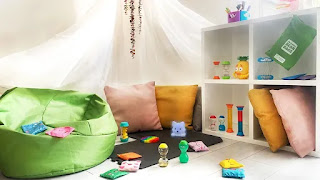In today's fast-paced educational environments, where stimuli abound and pressures escalate, the need for designated calm down spaces in schools has never been more critical. These quiet corners serve as essential havens for students of all ages, providing a place to retreat, recalibrate, and regain composure. The effective design of these spaces can significantly enhance student well-being and facilitate a more inclusive and supportive learning environment. This blog post explores the fundamental principles of designing effective calm down spaces within schools, offering practical tips and creative solutions to ensure these areas are both functional and inviting.
Understanding the Importance of Calm Down Spaces
The Role of Calm Down Spaces in Emotional Regulation
Calm down spaces, sometimes referred to as "peace corners" or "quiet zones," are dedicated areas where students can go to manage sensory overload or emotional upheavals. These spaces are not just a refuge but a proactive tool to teach students self-regulation techniques. By allowing children a space to de-escalate from emotional highs without interruption, schools can foster resilience and a better psychological climate conducive to learning.
Considering remote control blinds can be a great addition; while the remote control blinds cost might be higher initially, they offer unparalleled convenience and control over lighting, making them a worthwhile investment for a more focused and comfortable environment.
Benefits for Students and Educators
For students, these spaces provide a safe outlet for expressing emotions, significantly reducing classroom disruptions. For educators, calm down corners offer a manageable strategy to support students emotionally without always needing to resort to disciplinary measures. This proactive approach can decrease classroom conflicts and enhance overall teacher effectiveness.
Key Components of an Effective Calm Down Space
Accessibility and Visibility
An effective calm down space should be easily accessible to all students while maintaining a sense of privacy. Ideally, these areas should be visible to educators (for safety reasons) but set apart enough to provide a private experience. The space should not feel like a punishment but rather a positive retreat.
Sensory Considerations
Incorporating sensory elements can significantly increase the effectiveness of calm down corners. This can include items that cater to different sensory needs such as soft lighting, noise-canceling headphones, tactile toys, comfortable seating, and visual relaxants like lava lamps or fish tanks. The goal is to provide sensory modulation tools that help students cope with sensory overload.
Designing the Space
Choosing the Right Location
Select a corner or section of the room that is away from high traffic areas but still within the teacher’s line of sight. Ensure the space is not by noisy areas such as doors or windows that face busy streets.
Appropriate Furnishings
Equip the space with soft, comfortable seating like bean bags, floor cushions, or small tents. Rugs and mats can also define the space visually and provide additional comfort. Furniture should be lightweight and easy to move, allowing the space to be adaptable and easily cleaned.
Calming Decor
Opt for calming colors like blues, greens, and grays for decorations. Wall decals, posters, and artworks featuring serene landscapes or positive affirmations can reinforce a peaceful atmosphere. The inclusion of plants can enhance the calming effect and improve air quality.
Implementing Calm Down Strategies
Strategy Signage
Create clear, simple signage or visual guides that instruct students on how to use the space effectively. This might include steps for deep breathing, guidelines for the duration of stay, or a checklist of activities to choose from, such as drawing, reading, or puzzle-solving.
Tools and Resources
Provide resources that cater to various coping mechanisms: stress balls, puzzle games, coloring books, and guided imagery headsets. Also, incorporate a timer to help students manage their time in the space effectively, promoting independence and self-regulation.
Educator Involvement
Training staff on the objectives and proper use of calm down spaces is crucial. Educators should know how to guide students to the area and when it’s appropriate to do so. Additionally, they should be equipped to help students process their emotions after they have used the space.
Conclusion: Enhancing School Environments
Well-designed calm down spaces are more than just a quiet corner; they are a vital part of a modern educational infrastructure that acknowledges the mental health challenges students face. By incorporating these spaces, schools can create a supportive environment that promotes emotional health, enhances learning outcomes, and prepares students with healthy coping mechanisms for life. Implementing these design principles and strategies effectively can revolutionize how schools handle emotional and sensory regulation, making a significant difference in the educational experience and well-being of students.

